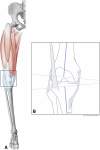The Chitranjan Ranawat award: is neutral mechanical alignment normal for all patients? The concept of constitutional varus
- PMID: 21656315
- PMCID: PMC3237976
- DOI: 10.1007/s11999-011-1936-5
The Chitranjan Ranawat award: is neutral mechanical alignment normal for all patients? The concept of constitutional varus
Abstract
Background: Most knee surgeons have believed during TKA neutral mechanical alignment should be restored. A number of patients may exist, however, for whom neutral mechanical alignment is abnormal. Patients with so-called "constitutional varus" knees have had varus alignment since they reached skeletal maturity. Restoring neutral alignment in these cases may in fact be abnormal and undesirable and would likely require some degree of medial soft tissue release to achieve neutral alignment.
Questions/purposes: We investigated what percentage of the normal population has constitutional varus knees and what are the contributing factors.
Subjects and methods: We recruited a cohort of 250 asymptomatic adult volunteers between 20 and 27 years old for this cross-sectional study. All volunteers had full-leg standing digital radiographs on which 19 alignment parameters were analyzed. The incidence of constitutional varus alignment was determined and contributing factors were analyzed using multivariate prediction models.
Results: Thirty-two percent of men and 17% of women had constitutional varus knees with a natural mechanical alignment of 3° varus or more. Constitutional varus was associated with increased sports activity during growth, increased femoral varus bowing, an increased varus femoral neck-shaft angle, and an increased femoral anatomic mechanical angle.
Conclusions: An important fraction of the normal population has a natural alignment at the end of growth of 3° varus or more. This might be a consequence of Hueter-Volkmann's law. Restoration of mechanical alignment to neutral in these cases may not be desirable and would be unnatural for them.
Figures




References
-
- Aglietti P, Buzzi R. Posteriorly stabilized total-condylar knee replacement: three to eight years’ follow-up of 85 knees. J Bone Joint Surg Br. 1988;70:211–216. - PubMed
-
- Bargren JH, Blaha JD, Freeman MA. Alignment in total knee arthroplasty: correlated biomechanical and clinical observations. Clin Orthop Relat Res. 1983;173:178–183. - PubMed
-
- Benjamin J. Component alignment in total knee arthroplasty. Instr Course Lect. 2006;55:405–412. - PubMed
Publication types
MeSH terms
LinkOut - more resources
Full Text Sources
Other Literature Sources
Medical

